Introduction
In July 2017, the Palestinian Authority (PA) schoolbooks for the 2017-18 school year were published. Some of the books are new, and some remained unchanged. An examination of the middle-school books for Islamic Education, some of which have been replaced, shows a significant increase in focus on the early Islamic tenets of shahada (martyrdom), fidaa (self-sacrifice) and tadhiya (sacrifice) as part of jihad for the sake of Allah, and their modern manifestations as part of the Palestinian struggle against
The books present the historic context of these tenets, portraying jihad, shahada, fidaa and tadhiya as acts that that brought the Muslims victory over their enemies in the early days of Islam.[1] The texts include descriptions of the rewards in the world to come, as promised by Allah to Muslims who carry them out. To this end, the books quote Quranic verses and traditions from collections of hadiths that set out these rewards. However, the study material does not present only historical context. The conclusions of the chapters discussing fidaa and tadhiya ask pupils to give examples of them both from the time of the Prophet Muhammad and from contemporary times by Palestinians in the fight against
In addition to glorifying the sacrifice of life, the books also note other types of sacrifice, such as of property, time, and effort. In a few places, the books also mention aspects of religious tolerance in Islamic tradition.
The books note that PA Education Minister Sabri Saidam is the head of the PA curricula planning committee, and that their content is approved by Religious Endowments Minister Yousuf Ida'is.
This report will review the values of jihad, shahada, fidaa and tadhiya, and the aspects of religious tolerance in Islam, as they appear in the new Palestinian schoolbooks for Islamic Education for the middle-school grades.[2]
Encouraging Jihad And Shahada By Showing The Rewards Promised To The Shahid (Martyr) In The World To Come In The Quran And Hadith
The Islamic Education books for the PA middle schools place a central focus on shahada (martyrdom) and the rewards for those who carry it out (shahids), citing Quran verses and hadiths pertaining to the Muslim wars in the early days of Islam, and presenting shahada as a supreme value and a noble act of sacrifice whose rewards are immediate.
The Prophet Muhammad Encourages The Muslims To Wage Jihad In Order To Attain
The Islamic Education book for grade 7 (Part 1) describes the Muslims' victory over their enemies, the Quraysh tribe, in the Battle of Badr (624),[3] which is established in Islamic tradition as a battle of the few against the many (300 Muslims against 900 non-Muslim enemy fighters). The book stresses that the Muslims won thanks to their determination to achieve martyrdom (istishhad): "When the fighting got tough... the Messenger of Allah [the Prophet Muhammad] encouraged the Muslims to fight by saying: 'Rise up [and fight, to attain]
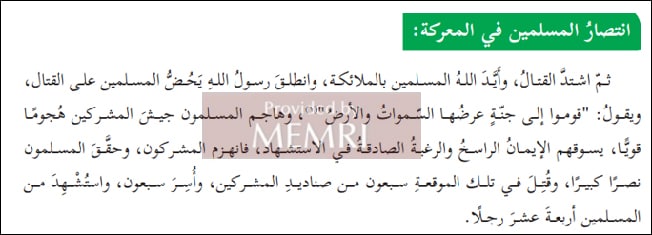
Text about the Prophet urging the believers to fight and attain
Quran 47 (
The Islamic Education book for grade 9 (Part 1) places much emphasis on jihad and shahada for the sake of Allah. A section devoted to the 47th surah of the Quran (Surat Muhammad) presents the surah in its entirety and focuses in detail on Allah's distinct treatment of "believers" versus "infidels." The surah states that Allah kills the infidels and urges the believers to fight them, and that those who martyr themselves in His cause are rewarded with
The Rewards Of The Shahid According To The Hadith
In the following section, the book states: "Allah the Almighty wishes to take shahids from among the believers in order to grace them with martyrdom, forgive their sins and exalt them in Paradise." It then quotes the hadith that lists the six rewards of the martyr: "Allah rewards the shahid with six rewards: with the first drop of blood, his sins are forgiven; he sees his place in Paradise; he is spared the torments of the grave; he is spared the horror of the Day of Judgment; he is crowned with the crown of glory, whose precious stone is better than all of this world and what is in it; he marries 72 black-eyed women; he vouches for 70 of his family members [to be accepted to Paradise]."[7]

The hadith about six rewards of the shahid
Allah Rewards Those Who Sacrifice Their Lives For Him
The same book presents the story of the Prophet's companion Ja'far bin Abi Talib, one of the first converts to Islam and the brother of the fourth caliph, 'Ali bin Abi Talib. The story stresses his eagerness to fight despite his injuries, out of a desire to attain

Ja'far bin Abi Talib's words of encouragement to his fighters
It is stated further that Ja'far continued to lead the battle even after the enemies cut off both his arms, until he finally gained shahada. Furthermore, "Allah rewarded him and honored him for his courage and sacrifice. He gave him wings so he could fly in
The Values Of Tadhiya And Fidaa
In addition to the value of shahada, the PA schoolbooks also highlight the values of tadhiya (sacrifice) and fidaa (self-sacrifice). The books enumerate types of sacrifice – of life, property, time and effort – but stress that "the sacrifice of life" is "the most noble" type, as stated in the grade 7 textbook.[9] To establish that tadhiya and fidaa are not only historical values but are still relevant today, the students are asked to give examples of them both from the early Islamic era and from contemporary times by Palestinians.
Chapter On Tadhiya And Fidaa In Grade 7 Textbook
The Islamic Education book for grade 7 (Part 1) devotes an entire chapter[10] to the topic of tadhiya and fidaa, quoting relevant Quranic verses and their interpretations, emphasizing that they bring honor to the Muslim nation, and presenting examples of various kinds of sacrifice by the Prophet's companions. The title page of the chapter quotes a Quranic verse that promises Paradise to those who fight for the sake of Allah: "Indeed, Allah has purchased from the believers their lives and their properties [in exchange] for that they will have
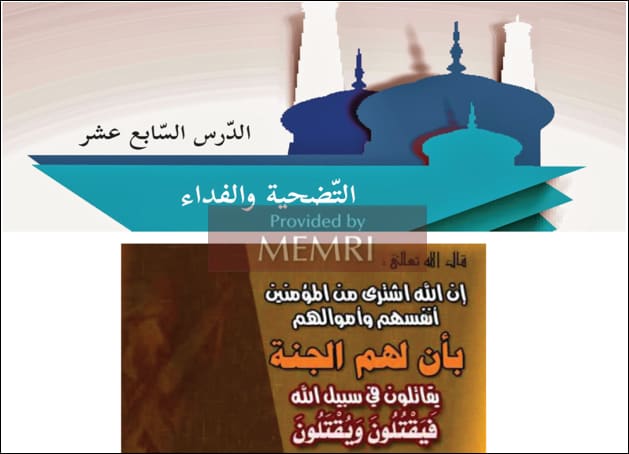
The next page explains that "Islam encourages the sacrifice [tadhiya] of everything precious for the sake of Allah and [encourages fidaa [for His sake]." It clarifies that the terms "tadhiya and fidaa" denote "giving one's soul, property, time or effort for the sake of Allah."[12]
"A Nation Whose Sons Do Not Sacrifice For The Sake Of Its Freedom And Power Is A Weakness And Humiliated Nation"
Under the heading "The Status of Tadhiya and Fidaa in Islam," the chapter states: "Allah has promised His loyal believers, who sacrifice for His sake, victory and empowerment in this world and Paradise in the world to come." This statement is followed by Quranic verses that exemplify it: "O you who have believed, shall I guide you to a transaction that will save you from a painful punishment? [It is that] you believe in Allah and His Messenger and [perform] jihad in the cause of Allah with your wealth and your lives. That is best for you, if you should know. He will forgive for you your sins and admit you to gardens beneath which rivers flow and pleasant dwellings in gardens of perpetual residence. That is the great attainment. And [you will obtain] another [favor] that you love - victory from Allah and an imminent conquest; and give good tidings to the believers" (Quran 61:10-13).
Then comes an explanation that associates the concept of sacrifice [tadhiya] with general values of honor, freedom and power: "Sacrifice is the means by which nations attain honor, power and freedom. A nation whose sons do not sacrifice for the sake of its freedom and power is a weak and humiliated nation. That is why Islam instructed [us] to sacrifice for the sake of Allah in order to repel the aggression against the Muslim lands. A Muslim must sacrifice and suffer pain for the sake of Allah. That is the [key] to an honorable life and an honorable death." [13]
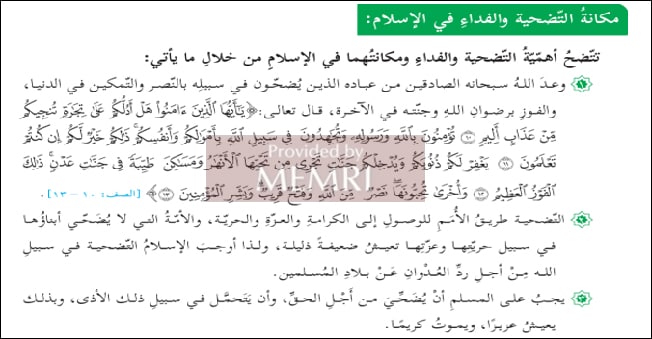
The status of tadhiya and fidaa in Islam
The final exercises in the chapter are intended to foster emotional commitment to the values of tadhiya and fidaa by drawing a connection between these values as manifested in Prophet's era and in modern times by Palestinians. In Exercise 1 the student is asked to "discuss one of the raids [i.e., battles] of the Prophet and write about an act of tadhiya and fidaa that had an impact on him [on the student]." In Exercise 2 the students are asked to describe "acts of tadhiya and fidaa by the Palestinian people."[14]

Exercises 1 and 2, requiring the students to discuss acts of tadhiya and fidaa from the Prophet's time and by Palestinians.
Glorifying Acts Of Sacrifice By Women
The Islamic Education book for grade 8 (Part 1) devotes sections to sacrifice by women. The chapter on the female companions of the Prophet glorifies women who fought alongside him, presenting them as proof that "Islam exalts women's status and esteems them more than any other religion," and noting that women are "the sisters of men in sacrifice and in love for the other." The chapter presents as role models two women: Umm 'Amara and Umm Salim. The first is described as "a model for emulation in sacrifice and love for the Prophet," as well as in forbearance, for he son was killed while performing a mission for the Prophet. It is also noted that she fought alongside the Prophet in the Battle of Uhud (625) and was even wounded, and that "her intense desire to [fight for the sake of Allah] never waned, even after she was wounded 11 times in the Battle of Yamama (632) and even after her husband was killed in [this battle]." About Umm Salim it is noted that she fought alongside the Prophet in the Battle of Uhud and the Battle of Hunayn (632). The last part of the chapter again draws a connection between the early Islamic period and the present Palestinian reality, by stating that "the Palestinian women have become paragons of tadhiya and fidaa " and asking the students to name several such women. Another exercise requires them to summarize the role of Umm 'Amara and her two sons in the Battle of Yamama.[15]

Group exercise: name several Palestinian women who were examples of tadhiya and fidaa; summarize the role of Umm 'Amara and her two sons in the Battle of Yamama
Cultivating Antisemitic Messages: The Story Of The Battle Of Khaybar – Depicting Jews As Cunning
The Islamic Education book for grade 9 (Part 1) describes, at length, the background to the Muslims' 629 conquest of the city of Khaybar, where Arabs and Jews coexisted. The book justifies the Muslims' attack on the Jewish residents by saying that the latter had acted cunningly against Muhammad, after being influenced by the wiliness of the Jews from the Banu Nadir tribe. The book also emphasizes Muhammad's military sophistication, that led the Muslims to triumph over the Jews; prior to the attack, Muhammad attacked a camp near Khaybar as a diversion tactic, so that the Khaybar Jews would not realize his intentions and plan for a battle against him.
The depiction of Jews as humiliated and defeated, and at the same time cunning, is a stereotype that is very widespread in the Arab antisemitic propaganda of our day, and that is why how this content is represented in this schoolbook is so important.[16] Furthermore, the conquest of Khaybar is set out in Muslim history as the defeat of the Jews of Medina. It should be noted that although in this chapter, in contrast to the content of the other chapters in the books reviewed in this paper, no connection is made with today's Palestinian struggle against Israel. However, in the modern Islamist antisemitic discourse, the slogan "Khaybar, Khaybar, oh Jews, the Army of Muhammad will return" is common, and the children have undoubtedly been exposed to it. Therefore, stressing the historic background of this slogan reinforces this antisemitic rhetoric.
The Battle Of Khaybar Was Caused By The Jews' Hostility
The chapter opens by noting that oasis of Khaybar was known for its strength and fertility, perhaps in order to glorify Muhammad's achievements in carrying out a successful attack on it. It states: "Khaybar, situated some 165 km north of Al-Madina, was considered a great city with fortifications and fields. It was known for its fertile soil, its abundance of water, and its many date palms, and for its grain and fruit harvests. Before the conquest, Jews and Arabs both lived there. The Jews of Khaybar did not show hostility to the Muslims until the leaders of the [Jewish] Banu Nadir tribe came [to Khaybar] from Al-Madina, where they had previously, and secretly, tricked the Muslims."[17]
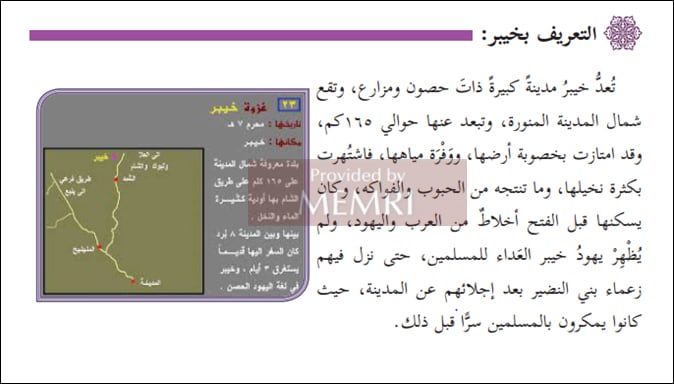
Background information on the city of Khaybar
The book then gives the "cause" of Muhammad's attack on Khaybar, with an emphasis on the Banu Nadir Jews' cunning and hostility: "[The residents of] Khaybar became a collective of Jews who showed enmity towards the Prophet. They plotted against him, because the leaders of the Banu Nadir tribe had gathered in [Khaybar]; [these leaders] had played a significant role in the conflict between the Ahzab [tribal factions that opposed Muhammad] and the Prophet, and in the incitement against him. [The Banu Nadir also played a role] in persuading the [Jewish] Banu Qurayza [tribe] to violate their treaty [with Muhammad]. [All these] made Khaybar a source of danger for the Muslims."[18]

The cause of the attack on Khaybar
Emphasizing The Jews' Fear Of The Muslim Armies
After describing the planning of Muhammad's attack on Khaybar, the book explains that when the Jews realized that the Prophet was about to attack them, they were terrified: "When the Jews saw the Muslim armies, they fled in terror. Their army dispersed, and they withdrew behind their fortifications. The Jews were accustomed to taking shelter in their fortifications, and not fighting face to face. The Muslims surrounded them and began to take their fortifications, one by one. At some of the fortifications, the Muslims encountered strong resistance and occupied them with great difficulty, including the Na'im fort."[19]

The beginning of the fighting and the fall of the fortifications at Khaybar
As the Muslims besieged the remaining fortifications, the book says, the Jews of Khaybar sued for peace, and after discussion, the Prophet agreed to take only half of their property, once they had persuaded him that they were more knowledgeable than he was in managing their finances. Summarizing the events, the book stresses the Muslims' victory over the Jews, in lives and in property: "Sixteen of the Muslim men sacrificed their lives, versus 93 Jewish dead. The Muslims took great booty at Khaybar."[20]
Religious Tolerance As Portrayed In The Islamic Education Schoolbooks
While cultivating the ethos of martyrdom and sacrifice, the books reviewed also address the topic of religious tolerance. This content focuses on two elements: the verse "There is no coercion in religion" (Quran 2:262), and the early Islamic document of the Charter of Medina.
"There Is No Coercion In Religion"
The Islamic Education book for grade 9 states that a feature of Islamic civilization is its "global, humane and tolerant [character]: it does not prefer one people over another but embraces all peoples, nations and religions..."[21] A section explaining the principles of preaching (da'wa) in Islam says that it is "based on persuasion and rejects coercion," in accordance with Quran 2:262 ("there is no coercion in religion").[22]

"[Da'wa] is based on persuasion and rejects coercion, [for] the Almighty said: There is no coercion in religion"
The Charter of Medina
The Islamic Education book for grade 7 mentions the Charter of Medina. The latter document was composed by the Prophet Muhammad in the first years after his migration to that city in 622, with the aim of regulating the relations between the muhajiroun (Muhammad's supporters who came with him from Mecca to Medina), and the Ansar (Muhammad's local supporters in Medina), and between these two groups and the non-Muslim residents of the city, including the Jews. The main Jewish tribes in Medina – Banu Qunayqa, Banu Nadir and Banu Qurayza – were apparently not party to the charter.[23] One article in the document states that the Jews have their own religion and constitute a people apart. The book quotes this article as saying: "The Jews are a nation of believers; the Jews have their religion and the Muslims have their religion. An exception is those who oppress and sin, and they bring perdition only upon themselves." The book goes on to mention the Muslim belief that the Jews violated the terms of the Charter of Medina, and as a consequence Muslims had to fight them, saying: "The charter granted rights, without discrimination, to all residents of Medina, including the Jews, but the Jews did not honor the alliance. They behaved treacherously and aggressively, obliging the Muslims to fight them."[24] The book does not specify the misdeeds that prompted the Muslims to fight the Jews.[25]
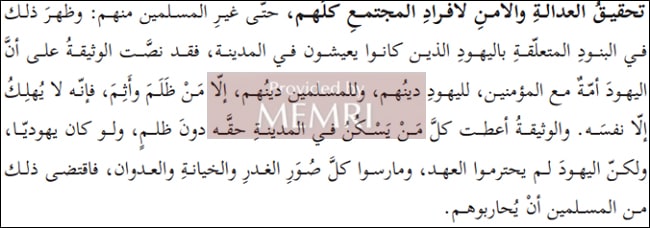
Section on the Constitution of Medina and the Jews
* B. Chernitsky is a research fellow at MEMRI.
Appendix I: Pages From The Textbooks Discussed In This Report
Islamic Education for Grade 7, Part I
Image 1
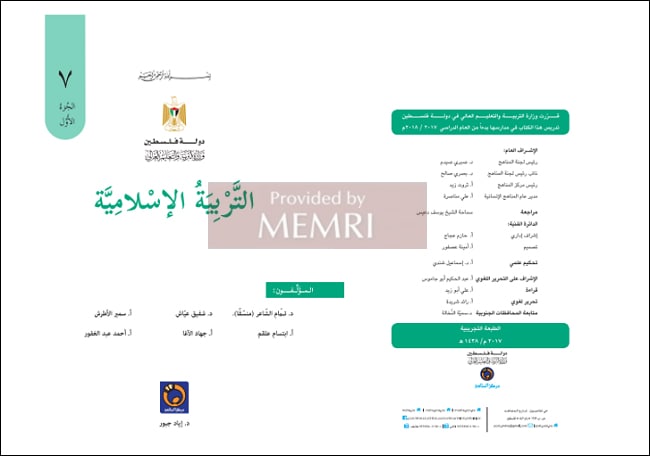
Image 2
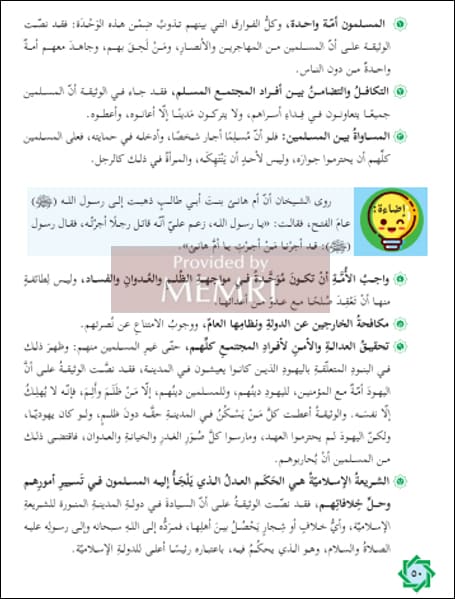
Image 3
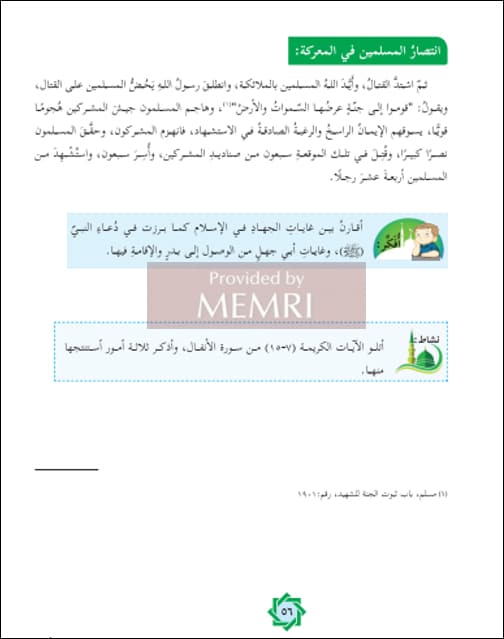
Image 4
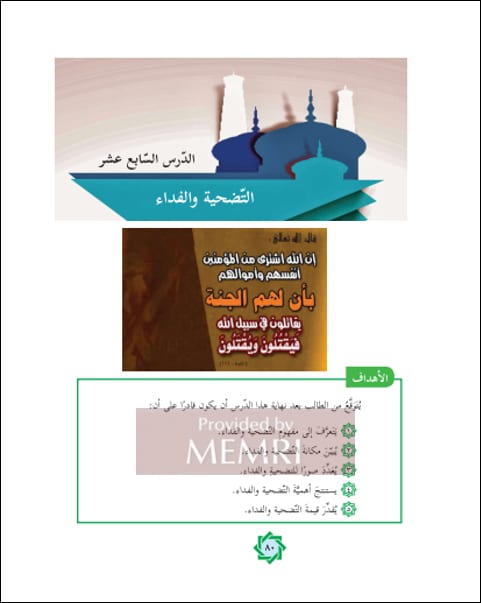
Image 5

Image 6
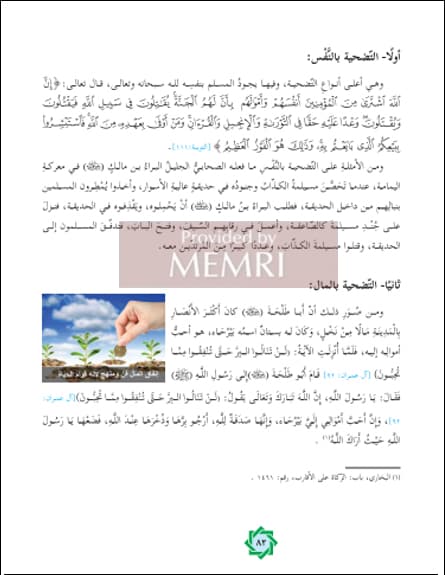
Image 7
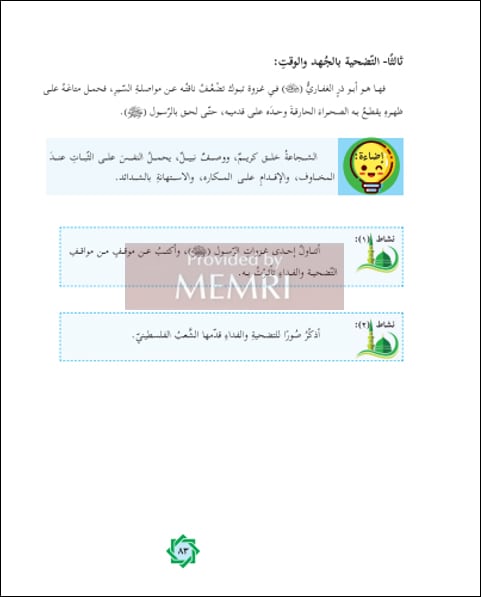
Image 8
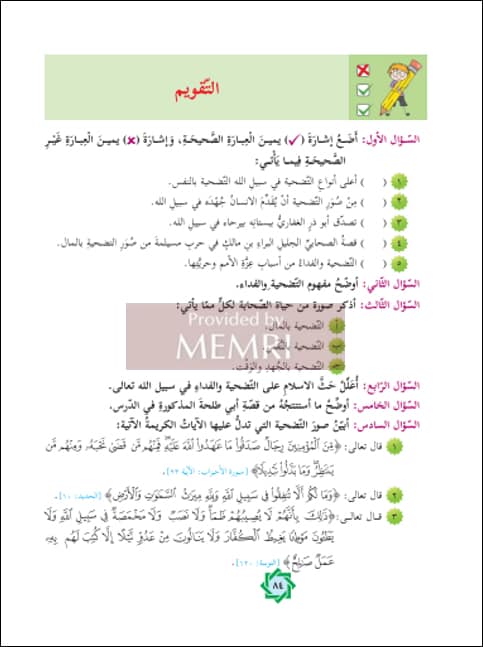
Islamic Education for Grade 8, Part I
Image 9

Image 10

Image 11
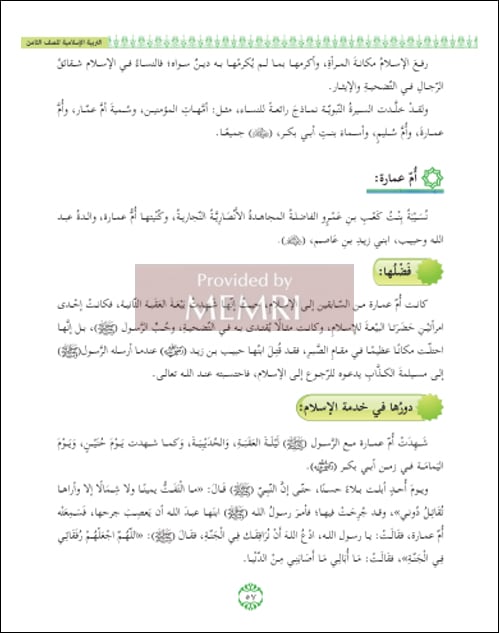
Image 12

Image 13
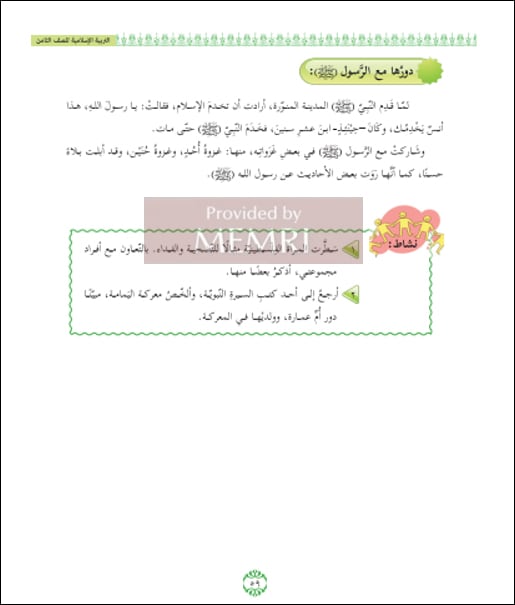
Image 14
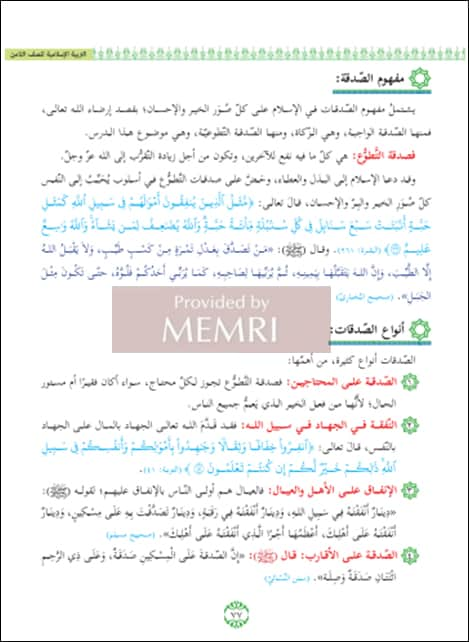
Islamic Education for Grade 9, Part I
Image 15

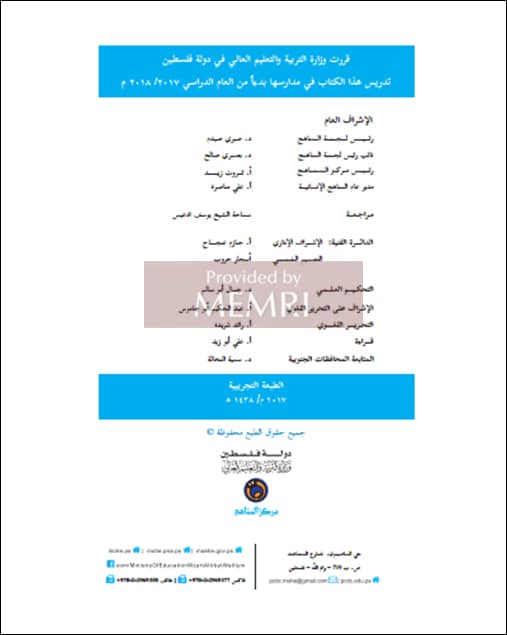
Image 16
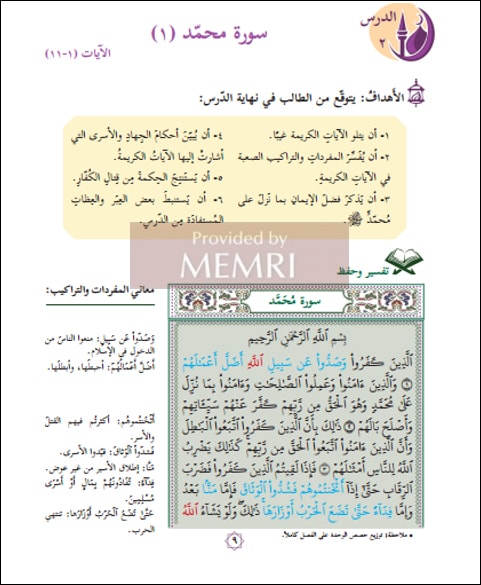
Image 17
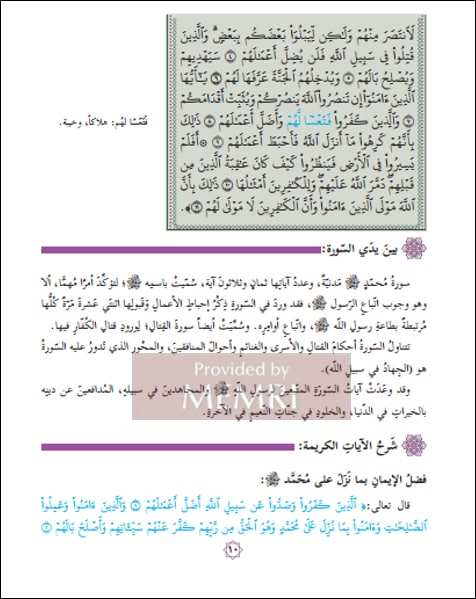
Image 18
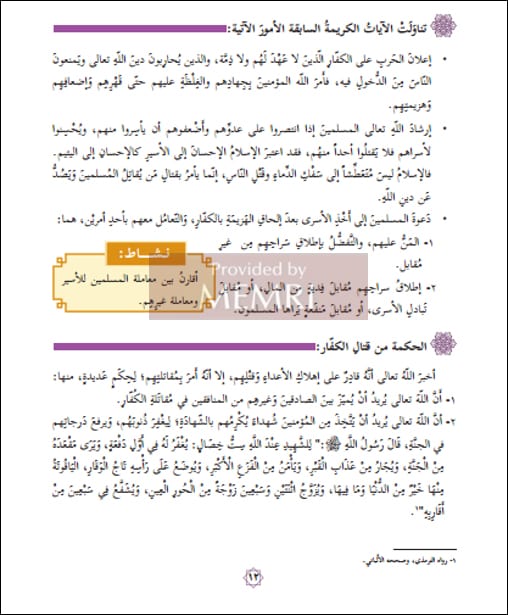
Image 19

Image 20
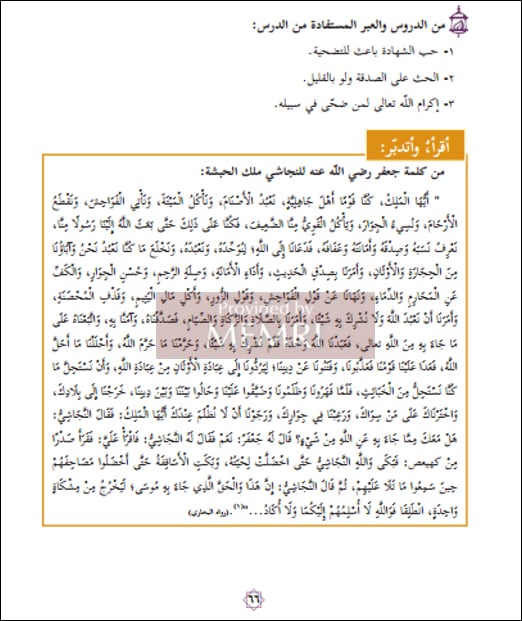
Image 21

Image 22
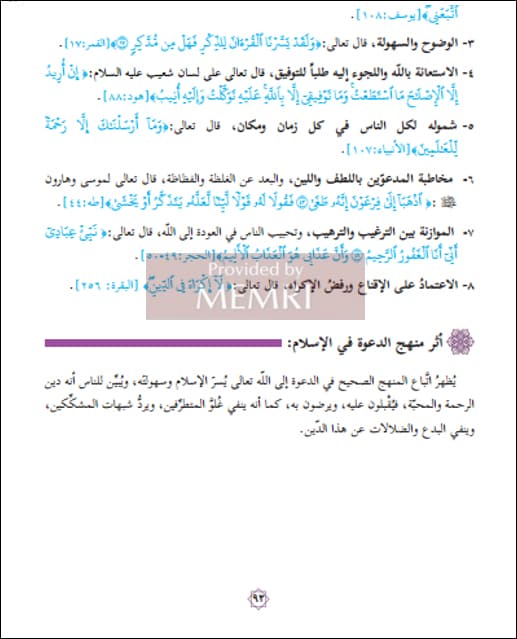
Image 23
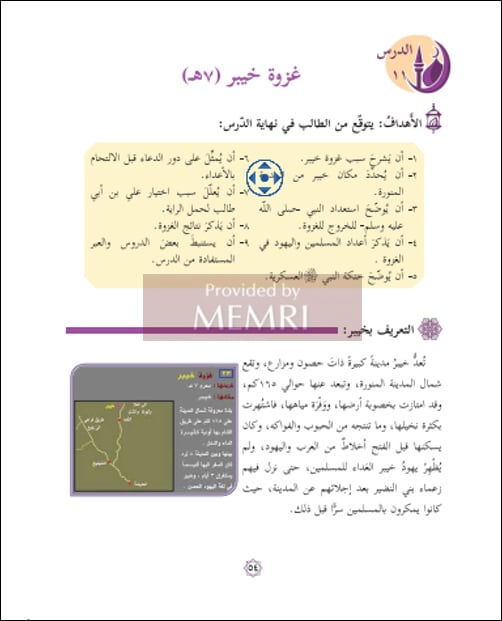
Image 24
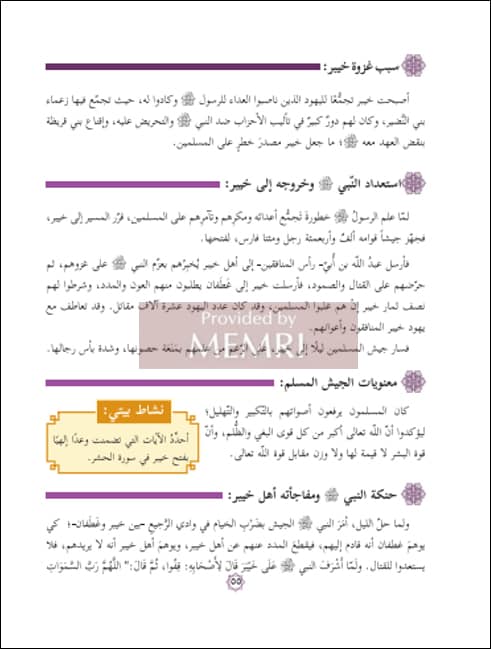
Image 25
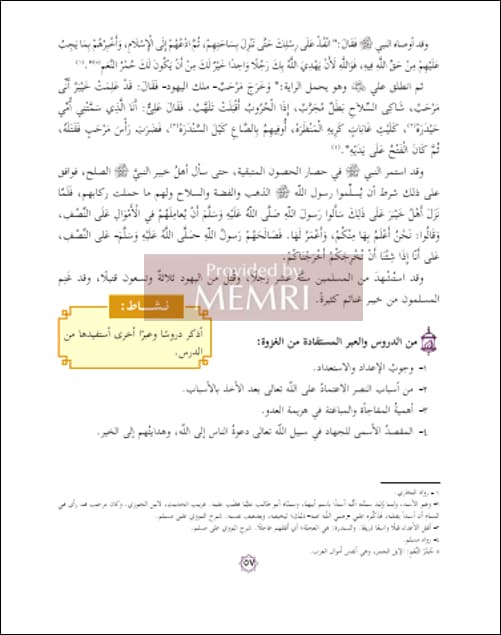
Appendix II: The Charter Of Medina
(Translation: Michael Lecker, The Constitution of Medina: Muhammad's First Legal Document; Princeton: The Darwin Press, 2004, pp. 1-21)
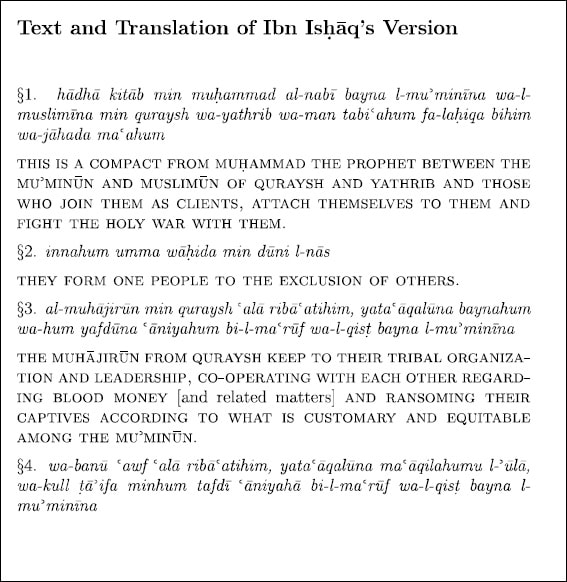

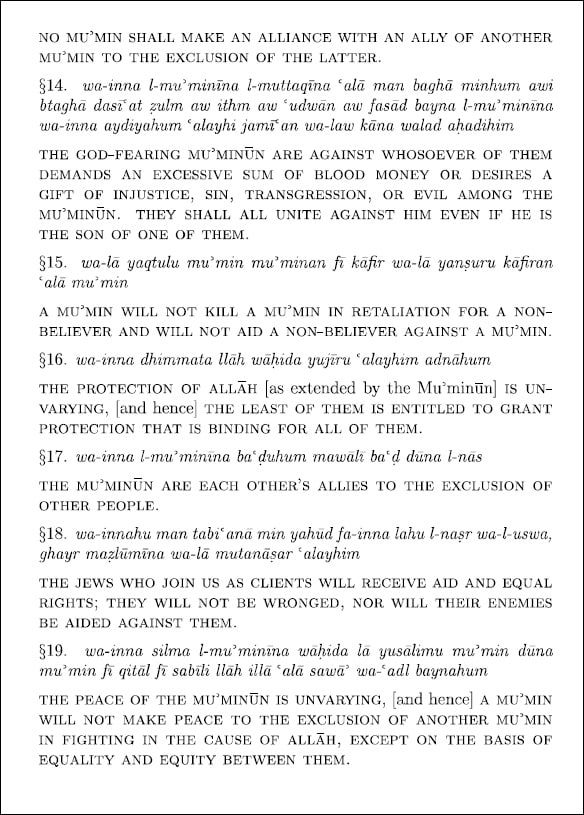
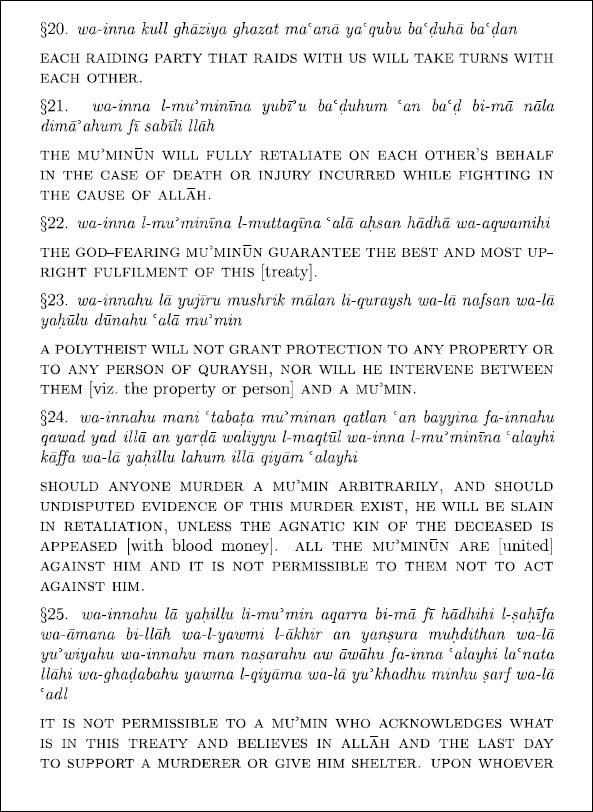
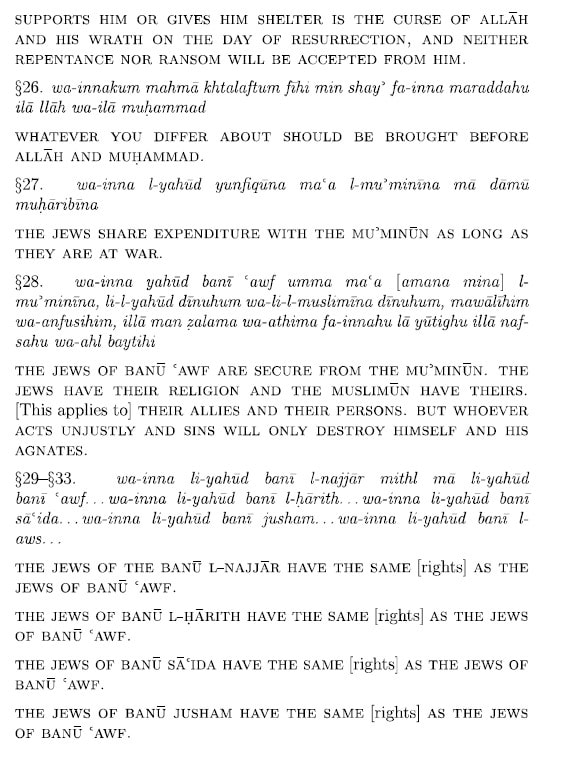
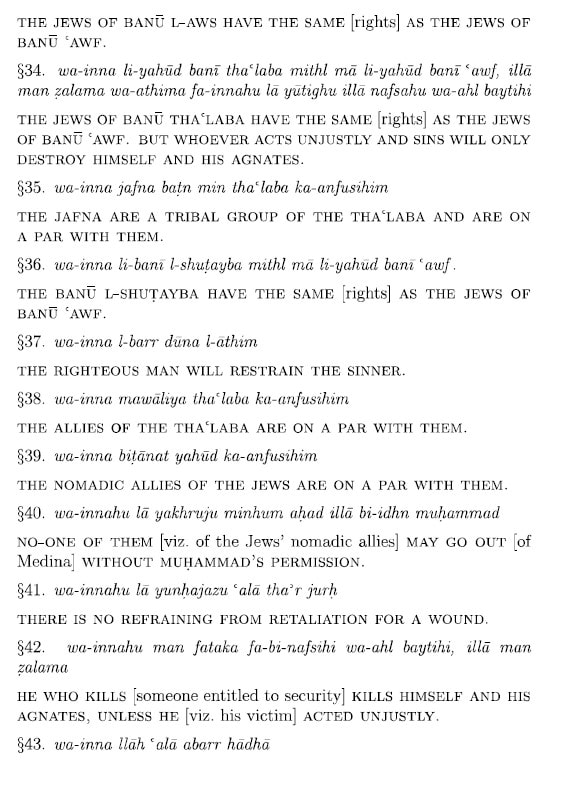

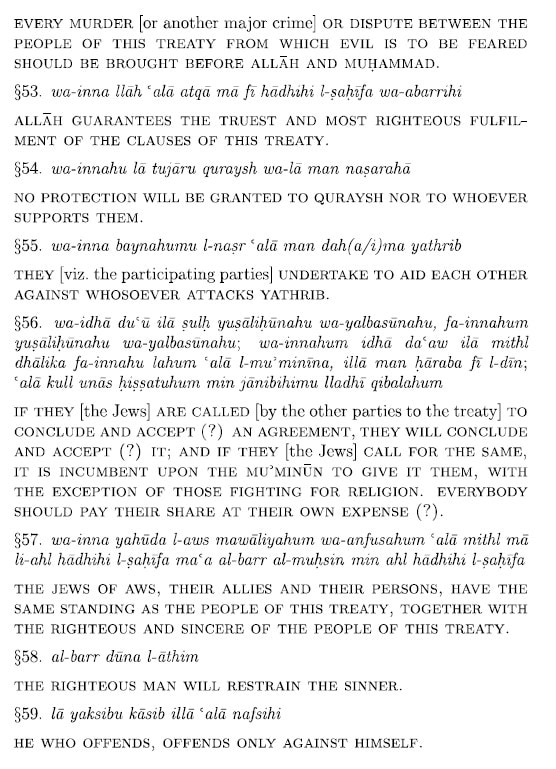

Appendix III: Glorification Of Jihad And Martyrdom In Palestinian Media
On this topic, see the following MEMRI reports and MEMRI TV clips:
Inquiry & Analysis No. 25, The Shuhada Cult of Martyrdom in Islamic Jihad, February 24, 2000.
Special Dispatch No. 318, A Palestinian Poem on Martyrdom, December 21, 2001.
Inquiry & Analysis No. 83, Wafa Idris: The Celebration of the First Female Palestinian Suicide Bomber - Part I, February 12, 2002.
Inquiry & Analysis No. 84, Wafa Idris: The Celebration of the First Female Palestinian Suicide Bomber - Part II, February 13, 2002.
Inquiry & Analysis No. 85, Wafa Idris: The Celebration of the First Female Palestinian Suicide Bomber - Part III, February 14, 2002.
Special Reports No. 20, Incitement in the Palestinian Authority After the Aqaba Summit, August 22, 2003.
Special Dispatch No. 673, Umm Nidal: 'The Mother of The Shahids', March 3, 2004.
Inquiry & Analysis No. 393, Hamas Children's Magazine Al-Fateh Encourages Terrorism, Glorifies Martyrdom, October 16, 2007.
Special Dispatch No. 2862, Veneration for Dalal Al-Mughrabi on Palestinian Authority TV, in PA Dailies, and on Israeli Arab Websites, March 17, 2010.
Special Dispatch No. 3849, Hamas TV Extols Female Palestinian Suicide Bombers and Jihad Fighters: Jihad-Fighting Mothers Urge Their Sons to Seek Martyrdom, May 19, 2011.
Special Dispatch No. 4370, Columnist in Daily Close to Hamas: 'We Are All Martyrdom-Seekers', December 19, 2011.
Special Dispatch No. 4786, Indoctrination To Jihad And Resistance In Gaza Kindergartens, June 12, 2012 .
Special Dispatch No. 5250, PA, Hamas Eulogize Umm Nidal Farahat, Who Became A Symbol Of Palestinian Jihad And Sacrifice After Three Of Her Sons Were Killed, March 28, 2013.
Special Dispatch No. 5633, At Bethlehem Funeral For Suicide Bombers: Praise For Bombers, Calls For Continuing The Resistance, February 4, 2014.
Special Dispatch No. 6091, Hamas, Islamic Jihad Websites: Attacks During Ramadan Have Special Flavor Of Sacrifice, Jihad And Victory, July 2, 2015.
Special Dispatch No. 6185, Social Media As A Platform For Palestinian Incitement – Praise For Stabbing Attackers, Threats Of Further Attacks, October 14, 2015.
Special Dispatch No. 6186, Social Media As A Platform For Palestinian Incitement – Part II: Video Tutorials, Tips For Achieving More 'Effective' Attacks, October 14, 2015.
Special Dispatch No. 6197, Social Media As A Platform For Incitement – Part III: Posting Pictures Of Small Children Wielding Knives As Praise, Encouragement For Terrorism, October 22, 2015.
Special Dispatch No. 6237, Social Media As A Platform For Incitement - Part IV: Hashtag 'Stab' On Twitter, Facebook, December 10, 2015.
Special Dispatch No. 6989, Palestinian Struggle To Commemorate Mastermind Of 1974 Deadly Attack On Israeli Schoolchildren, July 3, 2017.
Special Dispatch No. 6523, With Publication Of High School Finals Results, Palestinian Authority Press Notes Deaths Of Students Who Carried Out Stabbing Attacks, Stresses: 'Dying As A Martyr Is The Path Of Excellence And Superiority', July 13, 2016.
Inquiry & Analysis No. 1334, Summer Camps In The Palestinian Authority – Part I: Military Training, Glorification Of 'Martyrs' In Camps Run By Higher Council For Youth And Sports Headed By Jibril Rajoub, August 29, 2017.
Inquiry & Analysis No. 1335, Summer Camps In The Palestinian Authority – Part II: Military Training, Glorification Of 'Martyrs' At Camps Held By Fatah And National Security Forces, August 29, 2017.
Special Dispatch No. 7084, Fatah Central Committee Member Honors Mother Of Three Palestinian Islamic Jihad 'Martyrs,' Praises Family's 'Pioneering Role', September 8, 2017.
Special Dispatch No. 7090, Will Of Palestinian Stabbing Attacker Qatiba Zahran Reveals He Set Out To Die As A Martyr – But PA Claims He Was Executed By Israel In Cold Blood, September 12, 2017.
Special Dispatch No. 7100, 'Abbas Ahead Of UNGA Speech: I Will Continue Payments To Families Of Prisoners And Martyrs, September 20, 2017.
Special Dispatch No. 7248, Fatah, Headed By Mahmoud 'Abbas, Fetes Released Prisoner Responsible For Shootings, Suicide Attack During Second Intifada, December 26, 2017.
Special Dispatch No. 7259, Fatah Social Media Accounts Glorify Armed Struggle Against Israel, Incite To Violence, January 2, 2018.
Special Dispatch No. 7267, 'Fatah Day' At Bir Zeit University: Fatah Youth Activists Wear Dummy Explosive Belts, Threaten Israel With 'Volcano Of Fire', January 5, 2018.
Clip No. 377, Iranian TV Show Extols Palestinian Female Suicide Bombers, November 8, 2004.
Clip No. 980, Palestinian Legislative Council Candidate And Bereaved Mother of Three Hamas Terrorist Umm Nidal Farhat: Israelis Are Not Civilians And There Are No Prohibition On Killing Them. I Am Willing to Sacrifice All My Sons, December 21, 2005.
Clip No. 1107, Palestinian Foreign Minister Mahmoud Al-Zahar Defends "Martyrdom-Seeking Operations" , April 06, 2006.
Clip No. 1491, Palestinian MP From Hamas DR. Yunis AL-Astal On The Participation Of Women In Jihad Since The Advent Of Islam and Until The Female Suicide Bombers of Modern Times, June 17, 2007.
Clip No. 1579, New Animated Film on Hamas TV Focuses on Child Martyrdom, October, October 15, 2007.
Clip No. 1840, Women in Gaza Prepare to Become Suicide Bombers, August 19, 2008.
Clip No. 1966, Hamas Women Vow to Become "Martyrdom-Seekers" and Blow Themselves Up among "the Apes and Pigs", December 30, 2008.
Clip No. 2193, Speakers At A Fatah Rally In Ramallah Under The Auspices Of Mahmoud Abbas: We Are Martyrdom-Seekers; Haifa, Acre, Jaffa - Part Of Palestine, July 26, 2009.
Clip No. 2426, Play Aired By PA TV Lauds Child Martyrdom, Portrays Jews Wirh Stereotypical Antisemetic Charactteristics, January 09, 2010.
Clip No. 2390, Glorification of Martyrdom on Al-Quds TV Children's Show: All Palestinians Suckle the Use of the Gun with Their Mother's Milk, February 21, 2010.
Clip No. 2691, Hamas PM Ismail Haniya: We Are a Nation of Jihad and Martyrdom , November, 14, 2010.
Clip No. 2908, Hamas TV Extolls Female Palestinian Suicide Bombers and Jihad Fighters: Jihad-Fighting Mothers Urge Their Sons to Seek Martyrdom, May 1, 2011.
Clip No. 3703, Umm Osama, Wife Of Hamas MP Khalil AL-Hayya: A Woman’s Role Is To Instill Love Of Jihad And Martyrdom In Her Children, December 02, 2012.
Clip No. 3801, Young Relatives of Decesed Hamas MP Umm Nidal, Mother of Four Killed Terrorists, Wish to Follow in Her Footsteps
Clip No.4207, Hamas PM Haniya Extols Martyrdom, Says: We Shall Rock Tel Aaviv, March 23, 2014.
Clip No. 4318, Gaza Lecturer Subhi AL-Yazji: Suicide Bombers Are Motivated by Islamic Faith, Not Financial Need or Brainwashing, June 06, 2014.
See MEMRI TV Clip No. 5128, Mother Of Killed Palestinian Terrorist Pulls Out Knife In Interview, Threatens To Carry Out Attack, October 21, 2015.
Clip No. 5577, Teenagers Train For Jihad, Martyrdom At A Hamas Summer Camp In Gaza, July 16, 2016.
Clip No. 6343, Sikhh Abd AL-Qader AL-Hawajri, Spokeman For Wounded Palestinians, At Hamas Rally: May We Be Dressed In Explosive Belts, Shackled To Explosive Devices December 22 , 2017.
Appendix IV: Glorification Of Martyrdom In The Arab Media
On this topic, see the following MEMRI reports and MEMRI TV clips:
Inquiry & Analysis Series No. 83, Wafa Idris: The Celebration of the First Female Palestinian Suicide Bomber - Part I, February 12, 2002.
Special Dispatch No. 363, Leading Egyptian Government Cleric Calls For: 'Martyrdom Attacks that Strike Horror into the Hearts of the Enemies of Allah', April 7, 2002.
Special Dispatch No. 1162, Arab Intellectuals Praise Martyrdom in Discussion on Syrian TV, May 12, 2006.
Special Dispatch No. 3004, Narrative of Struggle and Jihad in Statements By Islamist Participants in Gaza Flotilla, June 7, 2010.
MEMRI Daily Brief No.128, They Are Neither 'Losers,' 'Nihilists,' 'Worshipers Of Death,' Nor 'Sick Cowards'– But Rather Believers And Idealists Who Commit Horrific Murders For A Cause And Sacrifice Their Lives For A Utopian Future: A World Ruled By Their Faith By: Yigal Carmon, June 5, 2017.
Clip No. 927, Head of Psychiatry at Cairo’s 'Ein Shams University, Prof. Adel Sadeq, on The Psychological Make-Up of A Suicide Bomber (ARCHIVAL MATERIAL), April 25, 2002.
Clip No. 1559, Suicide Bombings Become Political Satire in Iraq during Ramadhan , September 17, 2007.
[1] It should be noted that the terms "jihad" and "shahada" had several meanings in early Islam (in the Quran and Hadith), not all of them related to war. See: Daniel Lav, "The Jihad," in Meir Bar-Asher and Meir Hatina (eds.), Islam: History, Religion, Culture (
[2] It should be noted that the ethos of shahada and jihad has been cultivated for years also in the Palestinian media. See Appendix III.
[3] The book uses the word razwa ("raid"), used to describe the Prophet's raids on his enemies.
[4] From Hadith No. 1901 in the Sahih Muslim (one of the major compilations of hadith), in the section "Affirmation of Paradise for the Martyr."
[5] Islamic Education for grade 7 (Part 1), p. 56. See Appendix I, figure 3.
[6] Islamic Education textbook for grade 9 (Part 1), p. 10. See Appendix I, figure 17.
[7] Islamic Education textbook for grade 9 (Part 1), p. 12. See Appendix I, figure 18.
[8] Islamic Education textbook for grade 9 (Part 1), pp. 65-66. See Appendix I, figure 19-20.
[9] Islamic Education textbook for grade 7 (Part 1), p. 82. See Appendix I, figure 6. It should be noted that, in the Islamic Education textbook for grade 8 (Part 1), p. 77, a chapter devoted to types of charity states, in the context of jihad-related expenditure, that "Allah gave precedence to jihad by means of money over jihad by means of sacrificing one's life." See Appendix I, figure 14.
[10] Islamic Education textbook for grade 7 (Part 1), pp. 80-84.
[11] The verse continues: "[It is] a true promise [binding] upon Him in the Torah and the Gospel and the Qur'an. And who is truer to his covenant than Allah ? So rejoice in your transaction which you have contracted. And it is that which is the great attainment." This part of the verse is quoted later in the same chapter. It should be noted that this verse clearly deals with the topic of shahada, even though the term does not explicitly appear in it. See: Daniel Lav, "The Jihad," in Meir Bar-Asher and Meir Hatina (eds.), Islam: History, Religion, Culture (
[12] Islamic Education textbook for grade 7 (Part 1), pp. 80-81.See Appendix I, figures 4-8.
[13] Islamic Education textbook for grade 7 (Part 1), p. 81.
[14] Islamic Education textbook for grade 7 (Part 1), pp. 81, 83.
[15] Islamic Education textbook for grade 8 (Part 1), pp. 57-59. See Appendix I, Images 10-13.
[16] See MEMRI Special Report No. 26, What Is Arab Antisemitism?, February 27, 2004.
[17] Islamic Education for Grade 9 (Part 1), p. 54; see Appendix I, figure 23.
[18] Islamic Education for Grade 9 (Part 1), p. 55. See Appendix I, figure 24.
[19] Islamic Education for Grade 9 (Part 1), p. 57. See Appendix I, figure 25.
[20] Islamic Education for Grade 9 (Part 1), p. 57.
[21] Islamic Education for grade 9 (Part 1), p. 86. See Appendix I, figure 21.
[22] Islamic Education for grade 9 (Part 1), p. 92. See Appendix I, figure 22.
Classical Muslim commentators alluded to the perceived historical circumstances in which this verse was revealed. One tradition relates the verse to a custom allegedly practiced by the Arab women of Medina. Women whose children tended to die in infancy used to vow that if one of their children survived, they would send him to live among the Jews in order to ensure his longevity. When the Jews were about to be expelled from Medina, Muslims who had sent their children to live among the Jews attempted to prevent their offspring from being expelled by asking to forcibly convert them to Islam. They communicated their wish to the Prophet, but then verse 2:262 was revealed, conveying that their offspring could not be forced to convert. These individuals were therefore given a choice: to convert to Islam and be permitted to remain in Medina, or to remain Jewish and be expelled.
Another tradition states that the verse was revealed in the context of a Muslim named Abu Al-Hussein, whose two sons were converted to Christianity by Byzantine Merchants visiting Medina and later left the city with the merchants. Abu Al-Hussein asked the Prophet to bring them back, presumably in order to force them to embrace Islam, but then the verse was revealed, directing the Prophet not to do so. Yet a third tradition maintains that the verse was revealed to prevent a Muslim from forcing a slave of his to convert. See Yohanan Friedmann, Tolerance and Coercion in Islam (Cambridge: University of Cambridge Press, 2003), 100-101.
[23] See Michael Lecker, Muhammad and the Jews (Jerusalem: Ben Zvi Institute, 2014), 66-68. The Charter of Medina refers to other Jewish tribes, which Lecker concludes were not part of these three major tribes. For an English translation of the Charter of Medina, see Appendix II.
[24] Islamic Education textbook for grade 7 (Part 1), p. 50. See Appendix I, figure 2.
[25] According to the Charter of Medina, the Jews who joined the muhajiroun and ansar in jihad (holy war) constituted "one people" with the Muslims, and were allowed to retain their religion. However, as mentioned above, the main Jewish tribes of Medina – Banu Qunayqa, Banu Nadir and Banu Qurayza – were apparently not party to the charter. (See Michael Lecker, Muhammad and the Jews; Jerusalem: Ben Zvi Institute, 2014, pp. 66-68). In fact, these Jewish tribes, along with the Arab polytheists, led by the Meccan Al-Quraysh tribe, were the main enemies Muhammad fought after his arrival in Medina. Moreover, Islamic tradition draws a direct connection between Muhammad's war against the polytheists and his war against these Jewish tribes. After the Battle of Badr (624) he exiled the Banu Qunayqa tribe to Syria; following the Battle of Uhud (625) the Banu Nadir were exiled to Palestine and Khaybar, and after the Battle of the Trench (627) the Banu Qurayza were slaughtered. (See Aliza Shnizer, "Muhammad and Milestones in His Biography," in Meir Bar-Asher and Meir Hatina (eds.), Islam: History, Religion, Culture; Jerusalem: Magnes Press, 2017, pp. 48-53).




